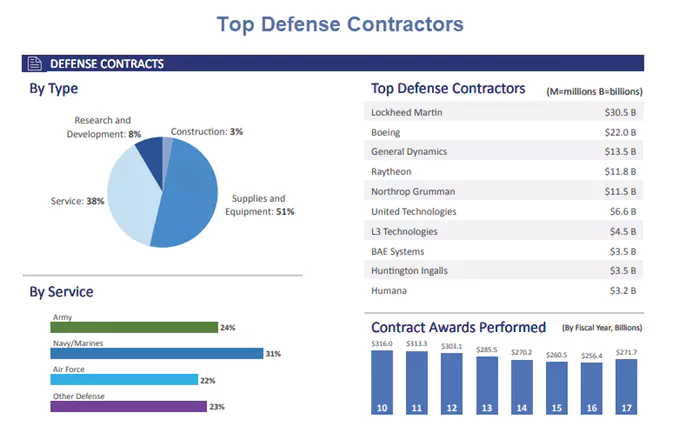A defense report, revised in March 2019 for fiscal year 2017, shows what states benefit the most from defense spending.
Please the US department of Defense report on Defense Spending by State for fiscal year 2017 as revised in March of 2019.
Conducted between June 2018 and November 2018, the analysis primarily entailed an examination of DoD prime and sub-contract award data and of defense personnel and payroll figures, which become reliable for analysis in March of each year. This report’s findings are drawn from numerous sources, including the DoD’s Defense Manpower Data Center; the U.S. Department of Commerce’s Bureau of Economic Analysis and Census Bureau; and USASpending.gov, which is managed by the U.S. Department of the Treasury.
Overview
In FY 2017, DoD spent $407 billion on contracts and payroll in all 50 states and the District of Columbia, approximately $1,466 per U.S. resident. This spending accounted for 2.3 percent of the country’s gross domestic product (GDP) in 2017, and was higher as a share of GDP than the $378.5 billion spent in FY 2016. Of these funds, $271.7 billion (67 percent) was spent on contracts for various products and services, while the remaining $135.3 billion (33 percent) paid the salaries of DoD personnel. Most contract spending went to supplies and equipment (51 percent) or services (38 percent). The remainder supported research and development (8 percent) or construction (3 percent). Personnel pay was allocated fairly equally amongst active duty military (41 percent), the National Guard and the Reserves (31 percent), and civilians (28 percent). With regard to total defense spending by state, funding varied from $393.6 million in Wyoming to $49 billion in California, averaging $7.98 billion per state. Almost 59 percent of that funding ($239.7 billion) went to 10 states.
If this funding is examined as a component of the states’ economies, a slightly different picture emerges. On average, defense spending accounted for 2.3 percent of all states’ GDP in FY 2017, ranging from 0.5 percent in Oregon to 8.9 percent in Virginia. The defense spending of $1.3 billion in Oregon, for example, was a small portion of its $240.7 billion GDP, while Virginia’s $46.2 billion in defense spending accounted for a relatively larger segment of its $517.6 billion GDP.
Top Defense Contractors
Top Spending Locations
There are 128 pages by state, down to the county level.
Vote Buying
This is how and why people support perpetual war.
Anyone who does not support perpetual war is labeled "weak on defense". And of course, no Congressmen ever turn down projects in their own district.
Finally, much defense spending is hidden. Homeland security costs are not considered "defense".
Perpetual War
In reality, hardly any of this spending is "defense". It's primarily "offense".
We need to make enemies to support perpetual war.
This material is based upon information that Sitka Pacific Capital Management considers reliable and endeavors to keep current, Sitka Pacific Capital Management does not assure that this material is accurate, current or complete, and it should not be relied upon as such.
Recommended Content
Editors’ Picks
AUD/USD posts gain, yet dive below 0.6500 amid Aussie CPI, ahead of US GDP

The Aussie Dollar finished Wednesday’s session with decent gains of 0.15% against the US Dollar, yet it retreated from weekly highs of 0.6529, which it hit after a hotter-than-expected inflation report. As the Asian session begins, the AUD/USD trades around 0.6495.
USD/JPY finds its highest bids since 1990, approaches 156.00

USD/JPY broke into its highest chart territory since June of 1990 on Wednesday, peaking near 155.40 for the first time in 34 years as the Japanese Yen continues to tumble across the broad FX market.
Gold stays firm amid higher US yields as traders await US GDP data

Gold recovers from recent losses, buoyed by market interest despite a stronger US Dollar and higher US Treasury yields. De-escalation of Middle East tensions contributed to increased market stability, denting the appetite for Gold buying.
Ethereum suffers slight pullback, Hong Kong spot ETH ETFs to begin trading on April 30

Ethereum suffered a brief decline on Wednesday afternoon despite increased accumulation from whales. This follows Ethereum restaking protocol Renzo restaked ETH crashing from its 1:1 peg with ETH and increased activities surrounding spot Ethereum ETFs.
Dow Jones Industrial Average hesitates on Wednesday as markets wait for key US data

The DJIA stumbled on Wednesday, falling from recent highs near 38,550.00 as investors ease off of Tuesday’s risk appetite. The index recovered as US data continues to vex financial markets that remain overwhelmingly focused on rate cuts from the US Fed.


